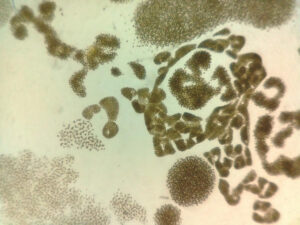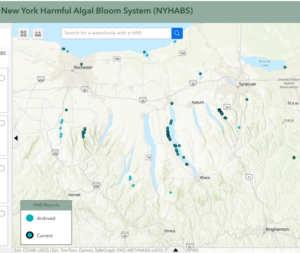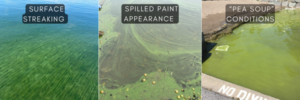We hope everyone had a great Fourth of July last Friday. This the first of our weekly Friday water quality report for the 2025 season. If at anytime water quality issues arise during the week, we will send out email notifications and reports on our social media platforms as well. Please encourage family and friends that also recreate on the lake, to sign-up for our email notifications so that they can stay informed on lake conditions as well. They can do so on the homepage of our website where you can also find our interactive map of bloom reports.
This week we have been notified by a few of our water quality monitoring volunteers that they have noticed changes in the color of the water and possible pre bloom-like conditions. CLWA and CLWC staff visited a few sites along the northwest side of the lake on Thursday afternoon but no visible blooms were found. Secchi disk readings dropped lower this week than normal. Last year at this time our average secchi reading was 5.9 meters – and this year it has dropped to 4.6 m already. We didn’t have an average reading that low until mid August in 2024. It isn’t always clear what causes these changes from one year to the next. But the recent heavy rains washing sediments and nutrients into the lake are likely a contributing factor.
CLWA volunteers with iolight microscopes have been looking at water samples and this is the first week they have found some Microsystis in them. CLWC staff also did 3 plankton tows with FLCC and found a diversity of zooplankton along with some minor concentrations of Microcystis in those samples this week as well. So while we haven’t had a bloom yet – unfortunately it looks like they will likely be arriving sooner rather than later. Some of our neighboring lakes have already had blooms this year. Conesus Lake, Waneta and Lamoka, Honeoye, Otisco, and now Cayuga Lake has had numerous widespread HABs reported this week.

photo from CLWA Volunteer Sally Napolitano showing Microsystis cyanobacteria

Remember – conditions can change rapidly. Please use caution when out on the lake and look for characteristics of CyanoHABs including water that looks like:
- Pea soup, spilled paint, surface streaks or scum
- Color’s that are typically green, blue-green or yellow but can also be brown, red or purple
- Typically found along shorelines or coves
The official volunteer CyanoHABs monitoring program will begin on July 25th and run through October 2nd, 2025 but we have encouraged our volunteers to still keep an eye out on conditions prior to this date and report if they suspect bloom-like conditions.
Please, to keep yourselves and pets safe, avoid any water conditions that appear to be bloom-like. Don’t hesitate to reach out to us at 585-394-5030 with any questions or email us at HABS@canandaigualakeassoc.org if you are concerned about water quality. Sending us photos of the water is strongly encouraged. Have a wonderful weekend and stay tuned.
About CyanoHABs
Cyanobacteria, sometimes referred to as blue-green algae because of their color, are among the oldest organisms on Earth. They are naturally occurring in our lakes, generally in low numbers.
When triggered by the perfect storm of conditions – such as heavy rains followed by a few days of warm weather with calm winds – cyanobacteria may begin to increase, forming “blooms”. CyanoHABs can appear quickly and persist for hours or days, or they can disappear almost as quickly as they formed.
Since previous research informs us that high levels of toxins (microcystin) may accompany the blooms, humans and our pets should avoid coming into contact with the water when an active bloom is observed.
How to identify blooms
Use visual cues to identify potential blooms. They can appear like pea soup, spilled paint, surface streaks or scum. The color is typically green, blue-green, or yellow, but can also be brown, red, or purple. When blooms are discovered, they are usually found along shorelines or in cove areas. They are most often seen along the stretch of shoreline that is impacted by the prevailing winds. However, during significant bloom events, sometimes they can be found in open water areas.
Visit the NYS DEC website to learn more about identifying blooms.

What should you do if you suspect a bloom
When in doubt, stay out!
- Don’t swim, wade, jetski, waterski or tube in a bloom.
- Shower if exposed to bloom conditions. Wash pets off if they have gone into bloom-infested waters.
- Don’t consume fish from the lake during blooms.
- Do not use PRIVATE water drawn from the lake during a bloom. Public water supplies have safeguards in place and can be utilized unless you are otherwise notified.
Report the bloom to the NYSDEC NYHABs portal: on.ny.gov/habform
CyanoHABs Links and Resources
Further reading on cHABs and their impacts on human and pet health
NYS Department of Health HABs Website
NYS Department of Environmental Conservation HABs Website
Information for Surface Water Drawers during HAB Season
Article on the Contributing Factors to HABs in Canandaigua Lake
If you have any questions please don’t hesitate to reach out to HABs@canandaigualakeassoc.org

